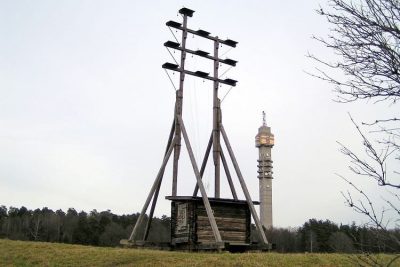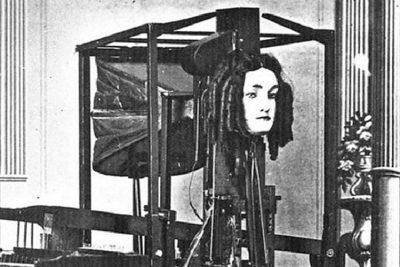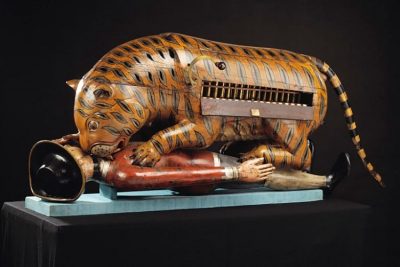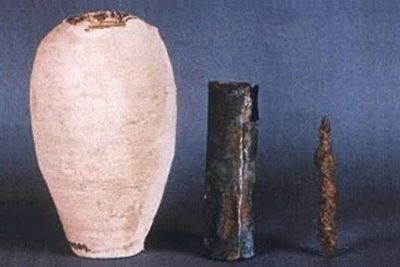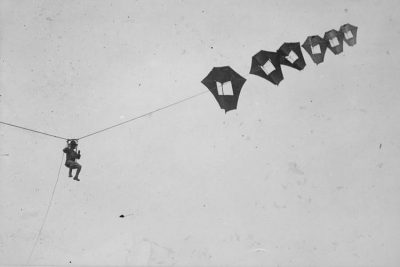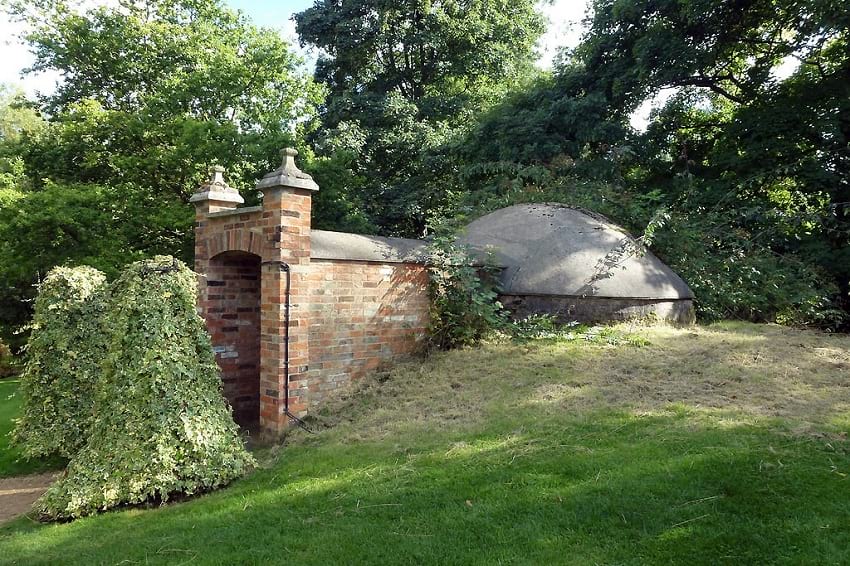The post This is the World’s First Apple Computer and It Was Released in 1976 appeared first on .
]]>
Apple I Computer at the Smithsonian Museum. It was assembled entirely in a wooden case by the owner. (Ed Uthman/Flickr)
The Apple Computer I retroactively known as Apple I was the first Apple desktop Computer, which was released by the Apple Computer Company in 1976. Designed and built by Steve ‘Woz’ Wozniak, an electronic engineer and Co-founder of Apple Inc. (as it is now called) along with Steve Jobs. They started the company from Job’s parent’s garage. The idea by Wozniak to sell the computer was financed by Jobs selling his Volkswagen Van (his only means of transport) and Woz selling an important programming calculator for $500. Apple is now the 9th richest company in the world according to Forbes so it appears the sacrifices were warranted.

Advertisement for the Apple I computer. (Apple Computer Company, Palo Alto, CA.)
Read more: The IBM Chess Computer That Beat Chess Grand Master Garry Kasparov in 1997
Apple l: only 200 units in total were produced
After selling their prized possessions, the power of the Apple I computer was first demonstrated and sold in July 1976 at the Homebrew Computer Club in California, USA. A computer store called Byte Shop bought 50 units of the 200 total produced and sold each unit at a price of $666.66, a little over $2,800 in today’s prices.
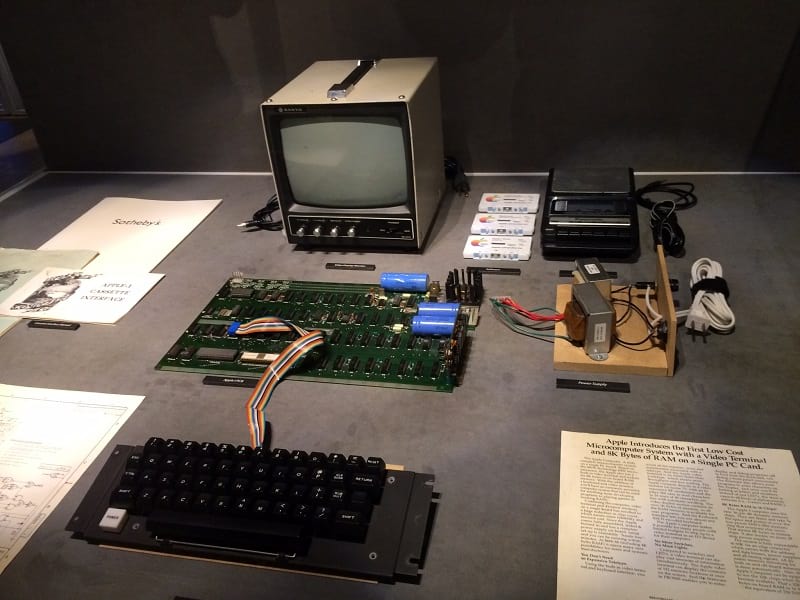
Apple I was as a bare circuit board to be sold as a kit with no other electronic parts—that people could use to build the computer. (Narnars0/Wikimedia Commons)
Apple I was a circuit board containing over 60 chips. It was not complete with the purchase however, a case, power transformers, power switch, ASCII keyboard and composite video display was needed for it to be a working computer. It had MOS 6502 microprocessors and a primitive 4 KB RAM. Mostly designed as a video game machine, it used the BASIC programming system allowing games to be both programmed and played. The reason Apple I was a success was ease of access- a keyboard and a cheap television were all that was needed to display the functions of the machine. Competing computers would require a lot more hardware. It would be discontinued only one year later due to the success of Apple II.
Apple l today is a much sought-after collector’s item

A working Apple I computer. (Cynde Moya/Wikimedia Commons)
VICE News ran an article and video where a computer historian named Corey Cohen booted up an Apple I made 42 years ago, demonstrating that it still runs perfectly today. Less than 50 exist for Jobs and Wozniak offering trade-ins back in 1977, so only 6 are said to exist in working order. For this reason and due to the success of Apple, they have become a rare and much sought-after collector’s item. For instance, an original Apple I was sold in 1999 for $50,000 at an auction. In 2010 another machine with packaging (including a return label with Steve Jobs parents’ address and a personal letter from Jobs with trouble-shooting attached) reached $210,000. By 2012, the price had hit a staggering $374,500 and $351,276 on two separate auction listings. Then, two years later – $905,000 was bid for the latest Apple I to sell.
Read more: A WWII Era Cipher Machine was the First-Ever Programmable Computer
In today’s world, you are probably never more than 5 feet away from an Apple device with modern computers dominating the globe. It is reported that almost 50% of households in the world have access to a computer–that’s over 3.9 Billion people. This began largely with Apple Inc. and that accomplishment is absolutely incredible, especially if you consider that the work started from a garage by two Californian teenagers.
For more unusual stories & intriguing news follow STSTW Media on Instagram and Facebook. Also, join our live chat discussion on Twitter.
Do you have a story/photo for us?
We welcome your contribution at [email protected]. Please include your name, city, state, and country.
Fact Analysis:
STSTW Media strives to deliver accurate information through careful research. However, things can go wrong. If you find the above article inaccurate or biased, please let us know at [email protected].
RELATED
The post This is the World’s First Apple Computer and It Was Released in 1976 appeared first on .
]]>The post Project Loon: A Series of Hot-Air Balloons in the Stratosphere That Bring Connectivity to the Remotest Places appeared first on .
]]>
Project loon high-altitude balloon being released. (Source: Loon)
Project Loon is a project that is undertaken by Google to provide rural and remote areas with internet access. A subordinate company of Alphabet Inc., Loon LLC, was formed to fulfil the task. Loon consists of a large network of balloons that are made to float on the “edge of space”, thereby providing the means of connection for people in the areas of the world that do not have proper or any access to the internet.
The company uses hot air balloons that are placed in the stratosphere at an altitude ranging between 18 km to 25 km. These balloons create a wireless network up in the air which has a speed of up to 4G- LTE. Project Loon was previously a research and development project that had been started by X, which was formerly known as Google X. It later developed into a company of its own, now known as Loon LLC.
Timeline of Project Loon
The idea to start project Loon began in 2008, when Google considered approaching Space Data Corporation to achieve something similar. Space Data Corp. is a company that provides wireless service & solutions for commercial and government users in regions with poor or no wireless coverage. They have previously achieved this by, sending internet-beaming balloon which carries them up to 32 km in the air, helping truckers and oil companies connect in the southern part of the United States. However, this contract between Google and Space Data Corp. did not materialise and Project Loon got delayed.
The project unofficially began in 2011 and started being developed under Google X, when they ran a number of trial runs in Central Valley, California. The project officially began on 14 June, 2013, and was announced as a project by Google.

Loon balloon after launch. (Source: Loon)
Google ran a pilot experiment in Christchurch, Canterbury, New Zealand with 30 antenna-equipped balloons on 16 June, 2013. It was launched in collaboration with the Civil Aviation Authority from the Tekapo area of the South Island. There were at least 50 local families in the Christchurch area who tested the connection.
After the trial run at New Zealand proved to be a success, Google had plans to send 300 balloons up to make a continuous string around various countries.
In May 2014, Astro Teller, the laboratories director of Google X, made an announcement saying that they would be creating a temporary base station which may be leased by mobile operators of the countries. Later that year, from the months of May to June, Google ran tests in Piaui, Brazil, on the loon balloons providing internet access, and had their first LTE experiments as well as the launch near the equator.
Google also partnered with France’s space agency Centre National d’études Spatiales (CNES), on the project in 2014. Over the next few years, they began to develop the project further so they could make the balloons last longer in the stratosphere. The number of days a balloon could survive in the stratosphere increased over a period of time from 50 days, to 130 days, and peaked at 187 days mark.
In 2016, Google also made an announcement saying that they had managed to attain a stable ‘laser connection’ between two balloons which spanned over a distance of 100 km. In the same year, they tested their auto launcher known as “Chicken Little”, at Roosevelt Roads which was an old naval station in Ceiba, Puerto Rico. However, in 2017, after the destruction that Hurricane Maria left in its wake, Google received authorisation to provide Puerto Rico with emergency LTE coverage immediately.
Loon also had a commercial agreement with Telkom Kenya, according to which Loon is supposed to be able to provide connectivity even to the most inaccessible and unserviceable regions of Kenya by 2019.

Loon stratospheric balloon. (Source: Loon)
The Loon balloon
The balloons used by Loon are produced by Raven Aerostar, and are made of polyethylene plastic which is approximately 0.076 mm thick. Each balloon is approximated to be the size of a tennis court, measuring 15 metres across and 12 metres tall, when it is fully inflated.
The balloons are made to withstand the harsh conditions prevalent in the stratosphere, and can survive there for a minimum of 100 days. The balloons can also endure huge fluctuations in temperature ranging from temperatures as low as -90°C to high temperatures right up to150°C.

Google loon balloon (Source: Loon)
The altitude of the stratospheric balloon is controlled by the ballonet, which is a smaller inner balloon. The change in airflow in the ballonet regulates the loon’s altitude.
The balloons consist of four crucial parts – the flight capsule, the solar panels, transceivers, and the parachute. The solar panels keep the equipment powered during the day time, and also charge an onboard battery for night time operation. The flight capsule consists of the system to command and control the balloon. The transceivers are used to transmit internet signals across the network of balloons which is sent down for people to access the internet. The parachute is used for control and descent of the balloon.

Solar panel used on loon balloon. (Source: Loon)
Project Loon in recent times
Project Loon reached a huge milestone in 2019, where Alphabet Inc.’s hot air balloons covered over 40 million kilometres. The balloon also created a record of its flight hours for a total of one million hours.
The loon balloons have automation software that collects data on wind forecast and accordingly builds maps on where it should travel. According to the head of engineering, Salvatore Candido, it is the software that directs and redirects the movements of the balloon and not the team of engineers that monitor them. Candido said,
“The first balloon allowed to fully execute this technique set a flight time record from Puerto Rico to Peru. I had never simultaneously felt smarter and dumber at the same time.”
Enjoyed this article? Also, check out “Submarine Communications Cables: All That It Takes to Keep the Internet Up and Running“.
Fact Analysis:
STSTW Media strives to deliver accurate information through careful research. However, things can go wrong. If you find the above article inaccurate or biased, please let us know at [email protected].
RELATED
The post Project Loon: A Series of Hot-Air Balloons in the Stratosphere That Bring Connectivity to the Remotest Places appeared first on .
]]>The post Colossus Computer: A WWII Era Cipher Machine was the First-Ever Programmable Computer appeared first on .
]]>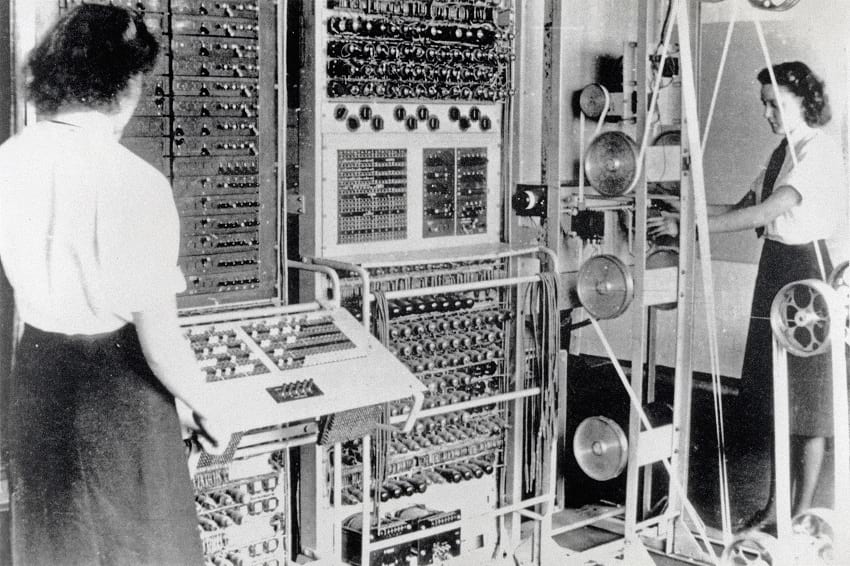
The colossus computer being operated by two Wrens. (The National Archives)
The origin of arguably one of the greatest modern inventions of man remains somewhat unknown to a major section of the world’s populace. We always, however, tend to forget the point of inception for all these geniuses, that is, the Colossus Computer. This was the first-ever programmable computer that was made in the history of technology.
The time of the Second World War witnessed a lot of rapid technological advancements that were necessary for the War. It birthed a number of inventions that are useful even today, while some others have provided the starting point to another major invention. The Colossus Computer was one such invention of the time by British code breakers. Its use was the cryptanalysis of the Lorenz Cipher. A stroke of luck and a group of absolute geniuses with a singular agenda was the formula that brought to life this critical invention.
Colossus computer: The secret of Bletchley Park
The German military used meticulous electronic transmissions to send important messages during the War that were intercepted by the British through two methods. One was the Enigma that used Morse code. The other is the less popular, codename Fish, that used electric teletypewriter technology to transmit messages between Hitler and his army high command in Berlin. Fish was a cipher machine, Lorenz SZ – 40/42, that the British called “Tunny.” In 1942, a lengthy technical battle later, the British code breakers finally succeeded in deciphering Tunny. The Colossus computer was consequently built to perform a fundamental function in this process at electronic speed. Prior to the invention of the Colossus, these British code breakers came out with a similar but much less reliable teleprinter cipher machine.

The Lorenz SZ42 machine. (TedColes / Wikimedia Commons)
Heath Robinson: WW2 codebreaking machine
Max Newman produced the functional specification of Heath Robinson and its engineering design was put together by Frank Morrell. The concept of the machine was brought to life, but the machine was anything but useful. The electromechanical parts were slow and it failed to synchronize the two test- paper tapes. One had the enciphered message, and the other had a part of the keystream of the Lorenz machine. Following this, the Colossus was created by the Department of Communications of British Foreign Office, which used electronic circuits for deciphering messages sent over the radio. The team was lead by Thomas Flowers and Maxwell Newman with important roles by Alan Turing and C. E. Wynn-Williams. The project was carried out in great secrecy at Government Code and Cipher School in Bletchley Park.

Tommy Harold Flowers. (Wikimedia Commons)
Tommy Flowers and his magic beanstalk
Tommy Flowers designed the Colossus. He was initially brought in to design the Heath Robinson’s combining unit but the function of tapes failed to impress him. He then came up with a design of his own that used an electronic analogue of the Lorenz machine and completely rejected the use of tapes. This design was then presented to Maxwell Newman, but the idea of one to two thousand thermionic valves (vacuum tubes) within a single machine was met with scepticism. Consequently, Tommy Flowers’ proposal was rejected.
Several other Robinsons were ordered thereafter. Eventually, persistence on Flowers’ part resulted in the birth of Mark 1 Colossus with advancements to the design. It had a record of one thousand and six hundred thermionic valves.
Colossus: The breakthrough
German operators often used the same wheel settings for two different messages which were famously called ‘depths.’ The interception of this was what pushed the British to the breakthrough they achieved in 1941. The operation of Tunny had an important process which included the operator sending a message of an unenciphered group of twelve letters that informed the receiver the starting position of the twelve letters. As per this, whatever the first letter was, the receiver would set his first psi-wheel position corresponding to the instruction. Two messages with the same indicator were all that the British needed to incur a depth. Since the first was corrupted due to atmospheric noise, the message was resent but with little deviations and abbreviations. An identical message would leave the British none the wiser.
The end: Start of a new beginning
The end of the War was accompanied by orders of Churchill for the destruction or dismantling of the Colossus machines. However, two of the machines were kept aside during the Cold War. Unfortunately, they were met with the same fate when technological advancements outgrew them. In 1991, however, saw the resurrection of the idea of the reinvention of the Colossus by Tony Sale. Thus began the journey of recreating this legendary machine with very limited knowledge about it. In 1996, the first part of the project was put on display in the presence of HRH, the Duke of Kent, and Tommy Flowers. The project reached its completion in 2007 and it was staged in an international Cipher Challenge contest.
As Flowers said,
“…I was told that the secret of Colossus was to be kept indefinitely… I was naturally disappointed. I was in no doubt, once it was a proven success, that Colossus was a historic breakthrough…”
It was perhaps the most heartbreakingly poignant ends that could be given to a “war hero” of the Colossus’ magnificent stature.

The reconstructed version of colossus computer at The National Museum of Computing, Bletchley Park. (TedColes / Wikimedia Commons)
Life has become tenfold simpler than it used to be back in the olden days. Operating a computer today has become child’s play, requiring you to simply open the appropriate program. This was not a possibility with the Colossus, because it was not able to store programs. To make it function as per requirements, modifications to the machine was required that included wiring, switching and plugging meticulously by hand. This entire process was a tiresome and hectic one, with the operators taking up almost three weeks to set up and debug a program. These machines are more famously called “program-controlled” computers. This sets up a comparison with the modern-day computers which are “stored – program” computers. The basic principle of the stored computer is only a thread of a long thought-process pulled out of Turing’s mind, in 1936. It is fascinating how far we have come with technology and how far we are yet to go.
Enjoyed this article? Also, check out “Deep Blue – The IBM Chess Computer that Beat Chess Grand Master Garry Kasparov in 1997“.
Fact Analysis:
STSTW Media strives to deliver accurate information through careful research. However, things can go wrong. If you find the above article inaccurate or biased, please let us know at [email protected].
RELATED
The post Colossus Computer: A WWII Era Cipher Machine was the First-Ever Programmable Computer appeared first on .
]]>The post Ice House: Here’s How Our Ancestors Stored Ice appeared first on .
]]>
An ice house in Barony Castle built in the year 1789. (© Copyright Jim Barton)
Way before the invention of the refrigerator, people stored ice all-year-round in special buildings called ice houses. Some of these ice houses were man-made underground chambers that were situated close to natural sources of ice, usually underground lakes. However, most of the ice houses that existed were specially constructed buildings with an exceptional quality of insulation.
During the winters, ice and snow were cut off from rivers and lakes. These blocks of ice were then taken to the ice houses, where they were packed with straw and sawdust, which acted as insulators. The ice would continue to stay frozen for many months – usually an entire year. This stored ice could later be used during the harsh summer months to make ice-cream, cold drinks and sorbet desserts. Despite the various uses of ice houses, its main function was the safe storage of perishable food.

Workers cutting blocks of ice from a frozen lake. (U.S. National Archives and Records Administration)
History of the ice house

Tablet of Zimri-Lim, where it is mentioned about an ice house to be built. (Photo by Jastrow / Wikimedia Commons)
Zimri Lim, the Ruler of Mari, a Northern Mesopotamian town, had sanctioned an ice house to be built aeons ago. This information is recorded in a cuneiform tablet from 1780 BC. Evidence points out that these primordial ice houses were regularly used in 1100 BC as well. Archaeologists have also recovered well-preserved remains of ice pits from China dating back to 700 BC.
During Alexander the Great’s military conquests starting in 336 BC, his soldiers stored ice and snow in pits that they dug in the ground. The Ancient Romans also traded ice during the summer months. This primitive Ice Trade involved snow brought in from the mountains that was stored in straw-covered pits. The snow that was stored in the bottom of the pit was sold at a much higher price than the snow that was skimmed off the top of the pit. The snow in the bottom layer was fresh and pure. It was mostly bought and used by well-to-do citizens of Rome like senators and merchants.
Ice houses in the United Kingdom
According to historians, people living in the United Kingdom were introduced to ice houses in 1660. Although there are various ways of constructing ice houses, British specimens are generally domed and brick-lined. Also, British ice houses had most of their volume safely stored underground. The shape of the ice houses was usually conical or rounded at the bottom, to hold the melted ice. These chambers were also connected to drains, which would then take away the melted water.

The exterior of Harewood House Ice House. (© Copyright John Webb)

The interior of Harewood House Ice House. (© Copyright John Webb)
It is theorised that ice houses in Britain were inspired by travellers who had seen similar construction in Italy, where farmers were known to store ice and snow in pits and cover it with straw. Until the early 1900s, ice was brought into the UK from Scandinavia. Around 1920, the inflow of ice dropped sharply as British factories perfected the manufacturing of artificial ice. Stunning examples of 19th-century ice houses can be seen scattered all over Britain in Bristol, Sussex, Warwickshire etc. The Tugnet Ice House in Spey Bay is the grandest ice house found intact in Britain. It was constructed around 1830 in order to store ice for packing the salmon that was caught in the Spey River.

Tugnet Ice House. (Photo © Anne Burgess)
The Ice Trade
The Ice Trade was a very important component of the economy of the East Coast of the USA during the early 1900s. It was especially very profitable in the New England region, where ice traders made huge amounts of money by transporting ice in straw-packed ships to the Southern states and the Caribbean Islands.

Frederic Tudor. (LOC)
Frederic Tudor, the person who founded the Ice Trade, also founded the Tudor Ice Company. He consequently came to be known as “Boston’s Ice King”. During the winter months, ice and snow were cut from the surface of lakes and shipped to an ice house by sledge. During summer, icemen delivered ice to homes in special vehicles called ice wagons. In homes, ice used to be stored in an icebox, which is a non-mechanical refrigeration device. It can be considered as a significant ancestor of the modern-day refrigerator.
After the invention of the refrigerator, home and business refrigeration became very commonplace. Slowly, the ice industry fell into decline and ice houses began to fall into disuse. In today’s world, most of the ice for household needs can be made inside a refrigerator. Ice for commercial use continues to be manufactured, distributed and sold in giant quantities for industrial purposes.

Young women delivering blocks of ice from an ice wagon, 1918. (U.S. National Archives and Records Administration)
Ice Trade in the Southern States
In the Southern states, notably Texas, ice houses are a cultural tradition. Ice merchants diversified their business and started to sell groceries, beer and soft drinks along with ice. This led to the foundation of early convenience stores. Interestingly, the 7-Eleven chain of convenience stores was also developed by Southland ice traders and manufacturers who operated out of Dallas and San Antonio. The 7-Eleven shops were previously known as the Tote’m Stores. In Texas, most of the old ice houses have now been transformed into chic al fresco bars. In a very interesting turn of events, in Texas, the word “ice house” refers to an establishment that makes most of its income by selling cold beer.
Munford, Inc. was another Southern company that diversified into convenience stores. In the 1970s, they operated a chain of stores called Majik Market. However, the company was sold in 1988 and filed for bankruptcy in 1990.
Using the example of ice houses, one can see how our lives have been simplified by virtue of modern technology. Prior to the invention of refrigeration technology, the consumption of ice was a very cumbersome and expensive process. Now, it is a staple that we do not even afford much consideration.
Yakhchal: The desert fridge

Yakhchāl in a desert, Iran. (Jeanne Menjoulet / Flickr)
Around 400 BC, Persians had invented a cooler that enabled them to store ice year-round. This cooler goes by the name of yakhchāl, which is a Persian word comprising of two words, ‘yakh’ meaning ice, and ‘chāl’ meaning pit. (Check out the full story on Yakhchāl)
The history of icehouses and ice trade in India
India’s tryst with icehouses can be traced back to the baraf khanas– buildings that stored and served ice as far back as the Mughal era. Some of these structures in Indian cities like Delhi, Lucknow, and Jaipur, have stood the test of time and are still open to visitors. The use of ice alcohol, water, and other drinks had become quite prominent in the 19th century, albeit it remained a practice that was restricted within the elite circles.
Ice was an expensive commodity which reached India at a time when the trade was already booming across Europe and America. The first ice imported to India, reportedly, came to Calcutta from Boston after being in transit for over four months. The booming of the ice-trade in India arose more as a convenience than a demand for luxury. During those days, India’s rate of export to the US was much higher than its import rate. Consequently, the ships on the return voyage were never loaded to the full capacity. To bridge the gap and make the business more economical, these ships began to be loaded with ice. This compromise ensured that the shipping of ice was actually quite cheap. That apart, it was soon realized that raw vegetables and fruits could be kept in optimum condition a lot longer if stored in ice while in transit. As a result, the demand for ice skyrocketed.
The American entrepreneur, Frederic Tudor (“Ice King”), built an icehouse in Chennai in 1842. This facility remained operational until 1882 and came to be known as Vivekanandar Illam. Though it closed down after other ways of making ice came into vogue and icehouses became passé, one can still visit the venue to see the remnants of India’s history of icehouses.

Vivekanandar Illam in Chennai, India. (SriniG / Wikimedia Commons)
Fact Analysis:
STSTW Media strives to deliver accurate information through careful research. However, things can go wrong. If you find the above article inaccurate or biased, please let us know at [email protected].
 Recommended Read:
Recommended Read:
The Ice King: Frederic Tudor and His Circle (Maritime) | by Carl Seaburg & Stanley Paterson
Genre:
Non-fiction > History
RELATED
The post Ice House: Here’s How Our Ancestors Stored Ice appeared first on .
]]>The post Leonardo’s Robot: Leonardo da Vinci’s Mechanical Knight and Other Robots appeared first on .
]]>
A recreation of Leonardo’s robot or mechanical knight based on his drawings. (Erik Möller / Wikimedia Commons)
Leonardo da Vinci, one of the greatest geniuses of the Italian Renaissance, designed and constructed a mechanical knight way back in 1495. According to historical sources, this mechanical knight was capable of humanistic movements.
Leonardo da Vinci — Genius of the Italian Renaissance
The Italian Renaissance was one of the greatest epochs in human history. During this period, there were extraordinary developments in art, sculpture, architecture, philosophy, literature, and many other human endeavours.
A rediscovery of Ancient Greek and Roman cultures—from surviving works that Islamic scholars had preserved as well as surviving art and sculptures— influenced and inspired most of the artists, sculptors, architects, writers, philosophers, and other intellectuals. Using the Greek and Roman works as their base, they built further on these to create astonishing masterpieces.
As you might expect, there was no dearth in geniuses engaged in these activities, but Leonardo da Vinci is a personality that still manages to tower over everyone.
In terms of output, he was not actually as prolific as some of his contemporaries. A restless spirit, he had a mind that overflowed with so many ideas that he didn’t have the time to bring them all into fruition. He painted only a few paintings, most of which are now very well-known, like the Monalisa, the Last Supper, and The Virgin and Child with Saint Anne. His fame rests on these as well as on the fact that he was a very multi-faceted man.
Apart from art, he could turn his hand at architecture, mechanics, armaments, and more. His many surviving notebooks are filled with designs and ideas. Some of which were advanced not only for his time but come across as amazing in ours as well.
Leonardo da Vinci’s mechanical knight
In 1957, the researcher Carlo Pedretti discovered some of Leonardo da Vinci’s sketchbooks that contained design notes for a mechanical knight. While there isn’t one single complete drawing of the mechanical knight—if Leonardo da Vinci made a complete drawing, it didn’t survive over the ages—there are many fragmented details of the design in various sketchbooks.
Historical accounts had already mentioned da Vinci’s famous Automa cavaliere that is Automaton knight. However, most people assumed these stories were exaggerated. The discovery of the notebooks proved this was not so.
Leonardo da Vinci designed the mechanical knight to impress his patron Ludovico Sforza, who was the ruler of Milan. In 1495, Ludovico Sforza had a pageant at his court and asked Leonardo da Vinci to oversee all the arrangements of the celebration. The latter, of course, outdid himself when he unveiled his mechanical knight at this gathering. Apparently, it left everyone there thunderstruck. They had never imagined seeing a machine that resembled an anatomically correct knight and, moreover, moved like one too.
Design of Leonardo’s robot
It is well-known that Leonardo da Vinci carried out extensive anatomical research. He even dissected cadavers and made detailed drawings of their interiors. As a result, he developed a deep understanding of the human body. He was able to figure out that it was the muscles that enabled the bones and joints to move.
When he designed his mechanical knight, he made sure it was anatomically correct. The knight has proportionate limbs and joints that follow the Canon of Proportions that Leonardo noted in the Vitruvian Man. Furthermore, he tried to incorporate the way human muscles worked into the design.
Clad in medieval German-Italian armour, Leonardo’s robot could move its arms and raise its own visor and wave its sword. It could also move its jaw and neck. Furthermore, it could sit, stand, lie down, and walk. These robotic movements were very advanced and human-like for that period. In fact, we can say that the mechanical knight was the first humanoid robot that the world ever knew.
How Leonardo’s robot worked
Known as Robot di Leonardo or Automa cavaliere, that is Automaton knight, the machine used two elaborate and connected systems made up of pulleys, cables, gears, and wheels to move. In his article ‘The da Vinci Robot’, Michael Moran tells us that one of these systems was a four-factor one and was used for the movements in the hands, wrists, elbows, and shoulders. Leonardo fitted this cylindrical system into the knight’s chest. The other system was external and tri-factor, and it was used to move the ankles, knees, and hips. All the movements were to the drumbeat.
Modern reconstructions of Leonardo’s robot
In 1996, Mark Rosheim, a modern-day researcher and robotics expert, studied Leonardo’s different design notes for the mechanical knight. Later, in 2002, he used them as blueprints to replicate the mechanical knight. Amazingly, he found that it worked exactly like the historical accounts had said it did.
In addition to creating a model of Leonardo’s robot, Mark Rosheim also used some of his design ideas to build robots for planetary exploration for NASA.
You can find how Rosheim built the mechanical knight as well as other of Leonardo’s robots—a programmable cart, a bell-ringing automaton, and a lion—in his book “Leonardo’s Lost Robots.”
There is also a research group of Leonardo da Vinci aficionados called Leonardo3. They have also engaged in discovering, interpreting, and reconstructing Leonardo da Vinci’s inventions.
Their book “Leonardo da Vinci’s Robots” contains reproductions of Leonardo’s original designs and manuscripts. Further, along with this book, Leonardo3 offers a kit with which you can have a go at building Leonardo da Vinci’s programmable cart yourself.
Other robots designed by Leonardo da Vinci
As mentioned above, Leonardo da Vinci used his engineering skills to design other robots as well. These include a mechanical lion that, like the knight, was capable of movement. It could walk and, supposedly, could also hold and offer flowers. While there are no eye-witness accounts of this lion, Leonardo apparently designed it for Guiliano de Medici to be given as a gift to the King of France. In 2009, the French museum, the Château du Clos Lucé and Parc, built a modern version of this lion.
Leonardo da Vinci was an incredible man for any age. His ideas and designs of robots have considerably aided the development of modern robotics. It is interesting to wonder about the things he might have achieved if he had access to many of our modern conveniences.
Enjoyed this article? Also, check out “The Turk: The 18th Century Automaton Chess Player was a Fore-Runner of Computer Age“.
Fact Analysis:
STSTW Media strives to deliver accurate information through careful research. However, things can go wrong. If you find the above article inaccurate or biased, please let us know at [email protected].
 Recommended Read:
Recommended Read:
Leonardo’s Lost Robots | By Mark Rosheim
Genre:
Non-fiction > Science
RELATED
The post Leonardo’s Robot: Leonardo da Vinci’s Mechanical Knight and Other Robots appeared first on .
]]>The post Optical Telegraph: Communication Before the Internet appeared first on .
]]>
A reproduction of an optical telegraph in Stockholm, Sweden. (CBX / Wikimedia Commons)
These days, long distance communication is so simple for those living in technologically developed countries. So simple, that us fortunate enough to have it cease to even think about it anymore – until there are connection problems or the battery runs out. Usually, it won’t take long until it returns, but if a pressing matter then we can visit a cafe for a charger or even go to a public library to use a computer. A possible backup will remain with the telephone line in case of emergency – many options are available in that aspect.
Imagine those in the past or those in developing countries who become lost, with no conduits for contacting anyone. They have to rely on the kindness of strangers but many still run the risk of being lost forever in foreign environments or in serious situations, with no way of contacting help. That is why the invention of the telegraph was so important, and even more so in terms of industry, business, politics and war. It was the first step towards the invention of the telephone and internet. From smoke, fire and drums at various points of the past to messages through the air at the speed of light. And with them, the world changed completely.
History of communication – ancient techniques
It is said that modern humans evolved around 1.7 million years ago. Small knit communities were the normality then, pressed by a lack of communication which brought about anxieties about the outside world. Any long distance messages were limited to the speed of a person’s foot or animal’s hooves. Tamed birds would increase this to the speed and directness of wings; however, it was less reliable to send carriers such as pigeons. Humans can travel around 6 KPH and horses 21 KPH if swapped regularly so it was a painstakingly slow transfer of information. Across large stretches of water, the time of arrival would rely on the velocity of boats and ships which would be slightly quicker. Otherwise, smoke signals and fire beacons have been used to send information for millennia but it can only be extremely basic data.
Invention of Optical Telegraph
Millions of years of surviving with primitive methods would begin to change in 1791 with the optical telegraph invented by Claude Chappe named Le systeme Chappe. Before this, he worked on prototype designs with his brother such as a pendulum system and a panel system. In regards to the maiden syncronised pendulum device, Claude Chappe explains,
“The first telegraphic correspondence… was done with two pendulum clocks that were kept in perfect synchrony; the face of the clocks was divided into ten parts, each part designating a different numeral …When the pointer of one clock passed over the number one wanted to indicate, a sound was made…. By representing the words in a dictionary with successive numbers one could thus transmit any thought. …”
The semaphore system would be preferred.
“… next consisted of a large horizontal beam, called a regulator, with two smaller wings, called indicators, mounted at the ends, seemingly mimicking a person with wide-outstretched arms, holding a signal flag in each hand. The angles of the indicators… could be varied in increments of 45 degrees, sufficient for the encoding of hundreds of symbols…”
Each tower could be as far as 20 kilometers away from each other with telescopes implemented among them. These telescopes would see the signals with as many as 196 different positions symbolising letters, numbers and phrases to illustrate any thought.
Vive la revolution!
While the technological revolution was sparked by Chappe it became synonymous with another revolution of the political variety. The first famous use of the Chappe system was during the French Revolution when the French Emperor Napoleon Bonaparte took advantage of it for his military campaign. Between Paris and Lille were 15 Semaphores in the space of 230 kilometers, one symbol could arrive in only ten minutes time. Napoleon came to power after the French Revolution and his legions amassed over 530 towers from Amsterdam to Rome – it is said that there were even plans to devise one across the Channel in Britain, a land he planned to conquer. A short message could take one hour between Amsterdam and Rome for instance. Before the optical telegraph, the same message arriving via horses would take roughly one month. Here is an example of an order which was sent to Italy during Napoleons’ campaign.
“The Legion of the South may recruit men in Turin from among the Piedmontese prisoners-of-war or Austrian deserters. However, it must not recruit men who are not from Piedmont.”

Illustration of signalling by Napoleonic semaphore line. (americanradiohistory.com)
Another was when Napoleon’s son was born in Paris. The concept is described infamous French literature with an Alexandre Dumas classic, The Count of Monte Cristo. The count himself uses the system for evil by creating a fraudulent message which creates financial upheaval in the French capital.
An outdated medium
Other countries made their own interpretations of the device, inspired by the French. This included across Western Europe, Scandinavia and into North America also. Yet, by this time it had already started to fall into decline with a modern advancement coming in the form of the electrical telegraph in 1844. When Napoleons’ French Army lost territory, many liberated countries would dismantle the telegraph, such as in the Netherlands when they defeated the French. The new system now used wires to transfer messages as well as radio waves in later years. They used the Morse Code as a language – defined by the Merriam Webster dictionary as, “…either of two codes consisting of variously spaced dots and dashes or long and short sounds used for transmitting messages by audible or visual signals.”
It would remain the premium source of communications up until the invention of telephones almost two centuries after. The electric telegraph way was not hampered by adverse weather conditions and it was harder for enemies to decipher.
The world today
Telegraphs gave birth to the idea of fast, long-distance communication. The inventions that evolved from them have changed the world more than most others. From millions of years of communication being resigned to how fast a person could run and then within two hundred years later, instantaneous transatlantic communication is truly remarkable.
The next step in this dawn age of modern technology is 5G (5th Generation) – a wireless system with supposed average download speeds of 1GB per second – that’s around 230 songs or a short film! A far cry from the days of smoke signals and semaphore. With telegraphs, the premium means of messaging only two hundred years ago, one cannot imagine what mediums will be being used in the future. Looking ahead to say, 2300, and the world of Sci-Fi will be very much a reality in that regard.
Enjoyed this article? Also, check out “Yellow Concrete Arrows Are the Last Reminders of Transcontinental Airway System“.
Fact Analysis:
STSTW Media strives to deliver accurate information through careful research. However, things can go wrong. If you find the above article inaccurate or biased, please let us know at [email protected].
RELATED
The post Optical Telegraph: Communication Before the Internet appeared first on .
]]>The post Euphonia: The Sad Story of Joseph Faber and His Creepy Machine That Made Ghostly Sounds appeared first on .
]]>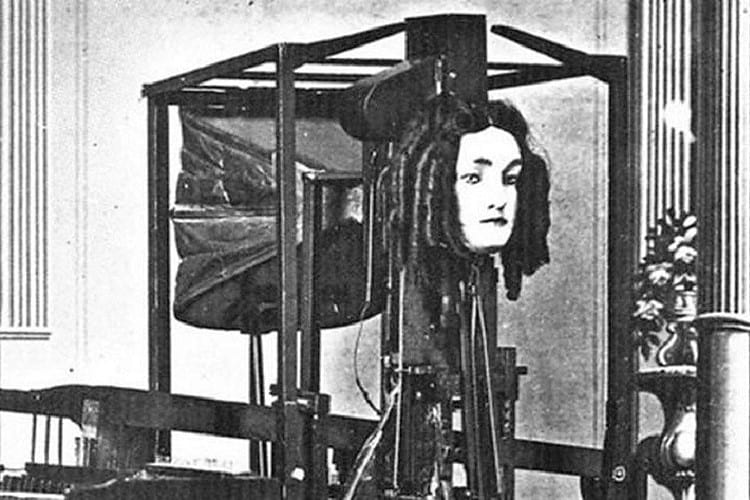
Euphonia, the talking machine. (Public Domain)
Today we all are familiar about Sophia, the walking-talking humanoid, of 2018. But, how many of us know that there was a talking machine called Euphonia in the United States during the 19th century?
A German immigrant named Joseph Faber is said to have built the creepy machine sometime in the 1800s. One end of the machine, Euphonia, had a woman’s head that spoke in sombre voice or ghostly monotone.
The talking machine appeared like a piano-like device with a female face having ringlet curls and staring vacantly at no one in particular. The actual meaning of Euphonia is ‘pleasant sounding’. In Latin, Euphonia is given a female identity. Faber originally did not think of designing the device to appear as a woman.
Theory of electromagnetic relay
In the 19th century, Euphonia was considered as an advanced machine that can talk. Joseph Faber would have been thankful to Joseph Henry who developed the theory of electromagnetic relay. This theory is the forerunner of Alexander Graham Bell’s telephone. Interestingly, Euphonia was based on Henry’s theory.
People admiring Faber’s talking machine believe that he advanced Henry’s technology while developing Euphonia. Faber installed 16 keys that could give basic sounds generally found in European languages.
These keys used a pneumatic system to push air to create a roar like sound through a replica of the human speech apparatus. Such a sound can be considered as a mechanically synthesised speech.
Advanced mechanics
There was a 17th key that helped in operating the glottis and in this case the mechanical one. With the help of such advanced mechanics of the day, Euphonia could speak in various European languages. Interestingly, it could also sing ‘God Save the Queen’ song.
Generally, Faber used to operate the keys and hoped to impress the audience.
Faber was born in a place called Freiburg in Germany sometime in 1800. In the early 1800s, he worked at the Vienna Observatory as an astronomer. But his eyesight got damaged due to an infection. In the 1820s, he tried perfected the concept of mechanical speech.
By 1843, Faber began showcasing his talking machine in Europe. The next year, he travelled to the United States to showcase Euphonia. Two years later he returned to Europe and exhibited Euphonia at the Egyptian Hall in London.
Deeply impressed with Faber’s clever device, Henry, who was director of the Smithsonian Institute, believed that with more research the machine could be developed as an audio telegraph device. Or, maybe it could broadcast sermons sometime in future.
Famous phonograph
While raving about Faber’s invention, Henry totally ignored the aspirations of a young Graham Bell, who went on to develop the now famous phonograph. The phonograph laid the foundation to the later-day telephone.
Meanwhile, the response of the audience in Europe to Euphonia was way below Faber’s anticipation. Very few people attended the Euphonia show and those who attended felt creepy.
With the result, Euphonia’s remained a short-lived curiosity.
So, why was Euphonia a failure?
Explaining the failure of Faber’s device, robotics expert Masahiro Mori said in 1970 that Euphonia was neither human-like nor non-human. It was somewhere in between. Hence, people of that era rejected it.
People felt creepy
Another aspect that needs to be noted is that people felt creepy when the woman’s face on the Euphonia device stared vacantly into the crowd.
After the failure of his European tour, Faber is claimed to have destroyed the Euphonia device, before taking his life in 1850. His suicidal act was termed as an obsessive preoccupation with scientific prototype turning into insanity.
It is by now that Faber’s machine had a disorienting impact on people of that era. To understand why Faber took years to build Euphonia and what he did or did not achieve in with his efforts, we need to understand the past.
Considered as heretical works
For centuries people have been making attempts to create contraptions that speak or walk. Take for example the myth of Pygmalion. In the 13th century, a philosopher named Albertus Magnus had invented a head that could speak. It is another issue that his student St. Thomas Aquinas destroyed it.
Others who made similar inventions include Roger Bacon, Abbß Mical and Friedrich von Knaus. However, all early speaking devices looked down as heretical works and therefore destroyed.
Interestingly, key evidence of a talking machine that really works came into prominence during the second half of the 18th century. A man simply named as Kratzenstein developed a set of 5 tubes that could utter the sounds of 5 basic vowels.
Faber got excited after coming across Kratzenstein’s formula and develop the Euphonia device. Though Euphonia failed, it successfully laid the foundation for the invention of today’s robotics and smartphone.
Enjoyed this article? Also, check out “Leonardo’s Robot: Leonardo da Vinci’s Mechanical Knight and Other Robots“.
Fact Analysis:
STSTW Media strives to deliver accurate information through careful research. However, things can go wrong. If you find the above article inaccurate or biased, please let us know at [email protected].
RELATED
The post Euphonia: The Sad Story of Joseph Faber and His Creepy Machine That Made Ghostly Sounds appeared first on .
]]>The post Important New Discovery May Provide Insights into the Construction of the Pyramid of Giza appeared first on .
]]>
Great Pyramid of Giza. (Nina Aldin Thune / Wikimedia Commons)
The pyramid structures of Egypt have for long baffled archaeologists and architects. The most famous of these are on the outskirts of Cairo, on the Giza Plateau. The Giza Pyramids are considered amongst the world’s largest structures built. The Great Pyramid of Giza, also known as the Pyramid of Khufu is the largest of the lot. It is built of 2.4 million stone blocks, each weighing approximately 2.5 tonnes.
For years, archaeologists have been confused with its existence and have tried to find out how ancient Egyptians succeeded in moving these blocks to build the world’s largest pyramid. It seems centuries later, we may finally have some answers. Archaeologists are one step closer to understanding the technique behind the structure constructed in 2560 B.C. which took 20 years to complete.
The history of the Great Pyramid
The Great Pyramid is the oldest structure considered as one of the Seven Wonders of the World. Apparently, the pyramid was constructed to serve as a tomb for the Egyptian king Khufu. The architect for this phenomenal man-made structure is assumed to be the pharaoh’s vizier, Hemiunu. His tomb is in close proximity to Khufu’s pyramid. The workmanship of the pyramid is almost flawless, with the four sides of the base having an average error of only 58 millimetres in length.
The colossal man-made structure has generated curiosity over the sheer volume of the pyramid and the intricacies involved during construction in an era which lacked current amenities and modern technology. It is believed to have been made up of approximately 2.4 million blocks, which were probably transported from the quarries around the area.

Close up photo of the Great Pyramid of Giza. (Soluvo / Wikimedia Commons)
The outer layer is made up of an estimated 5.5 million tonnes of limestone from the Tora region of ancient Egypt, across the river Nile. Apart from that, the construction of the pyramid would have required nearly 8,000 tonnes of granite and 500,000 tonnes of mortar. It was the tallest man-made structure at 146 metres, for over 3800 years. When built, it was protected with an outer layer of smooth Tora limestone. However, with time the casing has come off though, some of the limestone blocks are still present around the base.
The structure of the Pyramid of Giza
The construction of the pyramid has led to many hypotheses and has been the centre of archaeological research for a long time. The most established of these is the argument that the pyramid was constructed at two different places. The stones and slabs were cut to size and smoothened in the various quarries found around that area. It has been concluded that copper chisels and saws were used to cut and level soft stone like limestone. However, slabs of granite and basalt probably required other tedious techniques as well.
Once finished, the slabs or blocks were moved to the plateau area for final construction. The most controversial topic of discussion has been the moving of these massive blocks from the quarries to the actual place of construction. One of the widespread theories has been about the use of some sort of a ramp to move or roll the stones. An important archaeological discovery in 2013 of a logbook has a day-to-day account of the limestone transported from the quarry in Tora to Giza.
The diary of Merer, 2013
The French mission of Sorbonne University directed by Pierre Tallet came across documents with hieroglyphs and hieratic in 2013. These were discovered in a cave in Wadi al-Jarf on the Red Sea coast of Egypt. The documents are on papyrus, written by Merer, an officer of middle-ranking during the 26th year of Pharaoh Khufu’s reign. It is a logbook, known as the Diary of Merer, describing the several months it took to transport limestone from the quarries of Tora to Giza for use in the construction of the Great Pyramid.
Merer, it seems, had the responsibility of procuring the slabs from the limestone quarries in Tora. Limestone was used as a protective shell around the pyramid on the outside. The logs are for the months of July till November. The Diary of Merer was a breakthrough discovery regarding the construction of the Great Pyramid. It is the first historical reference to have been retrieved from an archaeological site giving information about the daily lives of the people who were involved in the construction. Egyptian archaeologist Zahi Hawass claims this to be “the greatest discovery in Egypt in the 21st century“.
The discovery at Hatnub, 2018
Out of the many, the one hypothesis that seemed to make sense considering the enormity of the blocks used was that the blocks were made in the nearby quarries and then moved to the location. An incredible discovery made a few days ago at Hatnub, an ancient alabaster quarry in the Eastern Desert of Egypt could just be the proof needed. The joint mission of IFAO – Institut français d’archéologie orientale (French Institute for Oriental Archaeology) in Cairo and the University of Liverpool in England, have been working at Hatnub together since 2012 to study the inscriptions and stelae at Hatnub.

The recently discovered quarry at Hatnub. (Hannah Pethen / Flickr)
According to the IFAO Director of the mission Dr. Yannis Gourdon, the mission came across a unique system during excavations at Hatnub. The remains of the system reveal a contraption that was probably used to transport the stone blocks up the steep ramp. The system per se, consists of a ramp in the centre with a staircase on either side. These staircases have holes on the sides which once would have held strong wooden posts. A sledge was probably used with ropes attached to the posts.
The University of Liverpool Director of the mission, Dr. Roland Enmarch assume that the blocks were pulled up from the quarry using this rope and pulley system which enabled the management of the weight of the blocks on slopes with a gradient of 20% or more. Archaeologists have not come across a pulley system like this anywhere else in the world.
In the wake of the latest discovery of October 2018, archaeologists and historians can probably start putting things together to get answers that have been desired for several years. Concrete proof may finally open us to the world of ancient civilisations and their ways. The Pyramids of Giza are living proof of the extent of knowledge that our ancestors possessed.
Recommended Visit:
Great Pyramid of Giza | Egypt
Fact Analysis:
STSTW Media strives to deliver accurate information through careful research. However, things can go wrong. If you find the above article inaccurate or biased, please let us know at [email protected].
RELATED
The post Important New Discovery May Provide Insights into the Construction of the Pyramid of Giza appeared first on .
]]>The post Ørsted’s Walney Wind Farm: The Largest Operational Offshore Wind Farm in the World appeared first on .
]]>
Offshore Walney Wind Farm. (David Dixon / geograph.org.uk)
Wind energy is renewable energy and, given the concerns over the future of fossil fuels, many countries are building offshore and land-based wind farms to power their communities. Walney Wind Farm, at present, is the largest operational offshore wind farm in the world. It was built at an estimated cost of $1.58 billion in the Irish Sea, about 15km west of Barrow-in-Furness in Cumbria, UK.
The project idea originated with DONG Energy, a renewable energy company that is now known as Ørsted. They had owned the project outright at the start and funded the project entirely. Now, they have joint ownership with Scottish and Southern Energy (SSE) and the Consortium of PGGM and Dutch Ampere Equity Fund. The wind farm generates around 367.2MW of energy and can supply electricity to over 300,000 households in the UK.
Understanding wind farms
Wind farms utilize wind turbines to harness the power of wind energy to generate electricity. The wind turbines have airfoil-shaped blades that connect via a drive shaft to an electric generator. The turbine blades spin when the wind blows on them and this spinning moves the drive shaft. The motion of the drive shaft turns the electric generator, and this results in the production of electricity.
As winds speeds are higher over water bodies than over land masses, offshore wind farms can generate more electricity. That said, winds blow at variable speeds. On some days, the wind speed will be exceptionally high, and, on some days, it will be quite low. Therefore, you won’t always get the same level of wind energy, resulting in different amounts of electricity generation.
Even so, you get higher electricity generation from offshore wind farms on seas, oceans, fjords, and lakes than from land-based wind farms. The offshore wind farms are built close to shore and use two types of turbines, fixed-bottom wind turbines in shallow water and floating wind turbines in deeper water.
Walney wind farm
Ørsted and its partners inaugurated the Walney wind farm in February 2012, and it has been in full operation since June 2012. They constructed the wind farm along a north-west to south-east direction. It has 102 turbines in an area of approximately 73 square km. The installation of the turbines happened in two phases, Walney I and Walney II, and the turbines began operating in April 2012. Underwater sea cables connect the turbine arrays to an offshore substation. After increasing the voltage from 34kV to 132kV, the substation exports it to an onshore substation. This substation connects to the national grid.

Seajacks Scylla installing the wind turbines at Walney Wind Farm. (Rossographer / geograph.org.uk)
Ørsted owns 50.1% of the wind farm, SSE owns 25.1%, and the Consortium of PGGM and Dutch Ampere Equity Fund owns 24.8 %. There is a 15-year agreement between Ørsted and the Consortium of PGGM and Dutch Ampere Equity Fund. As per this agreement, Ørsted must purchase the Consortium’s share of electricity from the project. Ørsted expects to sell this electricity to the local market.
Walney I
The construction on the Walney I phase of the wind farm began in March 2010, and the turbines became operational in May 2011. It has 51 Siemens turbines, with 3.6MW capacity, that DONG Energy installed in rows that are 749 meters to 958 meters apart from each other. Each turbine stands 137 meters in height and has a rotor diameter of 107 meters. There are 33kV array cables that are 92 km long and 132kV export cables that are 44 km and 43km long. The NKT cables group supplied the array cables, and the Prysmian Group provided the export cables. Seabed Power installed them. The Walney I phase of the wind farm generates electricity for over 160,000 homes in the UK.
Walney II
The Walney II phase also has 51 Siemens turbines with 3.6MW capacity, and, here too, DONG Energy spaced the turbines 749 meters to 958 meters apart. The turbines stand 150 meters in height and have rotor diameters of 120 meters. DONG Energy installed 49 of the Walney II phase turbines between June 2011 to September 2011. Bad weather delayed the installation of the last two turbines until March 2012. The company installed the array wires around the same time. A 132kV underwater cable connects Walney II to an onshore substation near Thornton Gate and transfers the generated power. Prysmian supplied the cables, and Draka Norsk Kabel (DNK) installed them.
Walney extension
The UK government, in 2014, permitted DONG Energy to develop an extension to the Walney wind farm. They have constructed 207 wind turbines on the Walney Extension. These turbines have a 750 MW capacity and can generate enough electricity to power around 600,000 homes in the UK.

Aerial photo of Walney Offshore Windfarm. (M J Richardson / geograph.org.uk)
An accidental oil spill near the Walney Wind Farm
In an ironic turn of events, the ecologically safe Walney Wind Farm became involved in an oil spill in 2014. Offshore Marine Services, a Danish firm, sent a dive vessel, OMS Pollux, to conduct routine inspection near the wind farm. During this inspection, the ship’s anchor cable broke, and the vessel crashed into a nearby turbine. Marine engine oil from the ship spilled into the ocean and trailed after it. According to the Liverpool Coastguard, the oil trail was around 10 meters wide and 0.7 nautical miles long. They assured the public that there would be no lasting ecological damage. The engine oil would soon disperse and evaporate.
Wind farms and health concerns
Governments and ecologically inclined companies tend to tout wind farms as producers of viable and safe energy. However, according to Neil D. Kelley, a scientist with the US Department of Energy, wind turbines are responsible for impulsive infrasound and low-frequency noise. This noise resonates within nearby building structures on a continuous basis and, along with annoying people who live in these building, it can also have an adverse impact on their health.
In the village of Fairlie, near Hunterston’s National Offshore Wind Turbine Test facility, residents have complained of numerous health problems arising from the nearby turbines. These complaints range from feeling dizzy, sick, and nauseous, and of suffering headaches, earaches, loss of coordination, speech impairment, and insomnia. Dr. Yelland, who has a PhD in Physics from Oxford, supported these health concerns in a letter to Health Protection Scotland. In his letter, he urged them to take cognizance of the documented harm caused by wind farms and to pay heed to local concerns.
Enjoyed this article? Also, check out “India’s Jharia Coalfield, a 100 Years of Simmering Greed“.
Fact Analysis:
STSTW Media strives to deliver accurate information through careful research. However, things can go wrong. If you find the above article inaccurate or biased, please let us know at [email protected].
RELATED
The post Ørsted’s Walney Wind Farm: The Largest Operational Offshore Wind Farm in the World appeared first on .
]]>The post The Summoning of Demons: The Dangers of Artificial Intelligence appeared first on .
]]>
Sophia the robot at 2017 Web Summit. (Web Summit / Flickr)
Once upon a time Sci-Fi films starring intelligent robots were deemed by many to be far-fetched as they depicted a future on Earth with artificial intelligence contributing as much to society as humans (and even more). Yet they fast became believable, such was and is the rise of automation in the real world. By now almost everyone has seen – at least a video – of a human-like robot for example, Sophia.
A.I has evolved so much that films like I-Robot starring Will Smith became less Sci-Fi or Fantasy and more like a documentary into what the future could hold.
A prevalent theme of such Dystopian films (including I-Robot) is that said intelligence could and would turn corrupt. Again, this is thought by many today to be implausible such is the confident human stance at the top of the food chain and our supposed sentient control over machines. Some people such as those in the know about technology: Elon Musk, Stephen Hawking and Bill Gates know better.
Because again, this is becoming more and more a reality with stories arising about artificial intelligence going against their masters albeit on a small scale at the moment. Never-the-less, A.I is having more responsibility and influence meaning this scale is rising, dangerously quickly if the supposed fear-mongers are to be believed. Recent examples show that things can go wrong and again brings up the question of security within A.I. Can they be trusted?
Why A.I?
A.I is moving on from prehistoric factory line robots – who can do jobs faster than humans but without the creativity – and moving forward to carry out the tasks of humans but also to think independently, outside-the-box in order to gain an advantage. This means they will find shortcuts with their vast stores of information which can cause problems as well as solutions. At the moment, menial tasks can be done but the scale and responsibility of such tasks are increasing rapidly such is the money it can generate and save.
The most potent threat is not about the robots developing a mind of their own which some people misconstrue but if said technology falls into the wrong hands such as that of a maniac who does not value human existence. They can contribute to social manipulation through vast target marketing as well as having the ability to analyse individuals, for example in China’s Social Credit system. This could cause chaos on a global scale by manipulating individuals, if it falls into the wrong hands.
Russian President Vladimir Putin spoke about both sides of A.I, mainly relating to the weaponry it can create;
“Artificial intelligence is the future, not only for Russia, but for all humankind. It comes with enormous opportunities, but also threats that are difficult to predict. Whoever becomes the leader in this sphere will become the ruler of the world.”
Dangers of Artificial Intelligence: Ghosts in the machine
Here are some examples of the issues starting to surface with A.I as they are given more room to roam. One such instance caused sexual discrimination within the offices of Amazon, something which should have been consigned to the past. It was incomprehensible that a futuristic machine would have the capability to do this but the reasons became apparent. This A.I was within a program designed to rate C.Vs of applicants. With large companies having thousands of applicants for each position, an automated way of sorting through them is an extreme time-safer. What they did not bank on however, was the machines being bias against sex.
At Amazon, as the data given to the A.I came from ten years of applications – in which males dominated the technology industry – the robots compiled their data from that. This was so extreme that even resumes with ‘Woman’ were punished such as Women’s clubs and colleges. Amazon of course, corrected the program but it did not guarantee that other errors had been made and therefore, never used to tool again except for less significant tasks.
It is reported that Amazon isn’t the only company using A.I in this way however.
“The company’s experiment, which Reuters is first to report, offers a case study in the limitations of machine learning. It also serves as a lesson to the growing list of large companies including Hilton Worldwide Holdings Inc. … and Goldman Sachs Group Inc. … that are looking to automate portions of the hiring process… Some 55 percent of U.S. human resources managers said artificial intelligence, or AI, would be a regular part of their work within the next five years, according to a 2017 survey by talent software firm CareerBuilder.”
In terms of being able to logistically evaluate populations, LinkedIn – a Microsoft invented professional social-networking site has executed this. Employers are able to find rankings of employees based on company positions. It also offers algorithms to match them with specific qualifications or abilities.
The Vice President does not trust it for hiring but values its worth. “I certainly would not trust any A.I system today to make a hiring decision on its own… The technology is just not ready yet.”
Another program supposedly gone wrong involved an artificial language created by A.I within Facebook. Two robots were intended to mimic human trading in the form of selling basic items like balls, hats and books. But Facebook was reported to shut down the program after the robots invented their own phrasing which was incomprehensible. As there was no reward to the bots – named Alice and Bob – for communicating in English they developed their own languages to be more efficient.
“Bob: i can i i everything else . . . . . . . . . . . . . .
Alice: balls have zero to me to me to me to me to me to me to me to me to
Bob: you i everything else . . . . . . . . . . . . . .
Alice: balls have a ball to me to me to me to me to me to me to me
Bob: i i can i i i everything else . . . . . . . . . . . . . .
Alice: balls have a ball to me to me to me to me to me to me to me
Bob: i . . . . . . . . . . . . . . . . . . .
Alice: balls have zero to me to me to me to me to me to me to me to me to
Bob: you i i i i i everything else . . . . . . . . . . . . . .
Alice: balls have 0 to me to me to me to me to me to me to me to me to
Bob: you i i i everything else . . . . . . . . . . . . . .
Alice: balls have zero to me to me to me to me to me to me to me to me to”
Facebook described these last reports as sensationalist journalism however and that the program was not shut down as robots creating new dialogue is not an issue. Dhruv Batra of Facebook’s Artificial Intelligence Research explains more,
“While the idea of AI agents inventing their own language may sound alarming/unexpected to people outside the field, it is a well-established sub-field of AI, with publications dating back decades.
Simply put, agents in environments attempting to solve a task will often find unintuitive ways to maximize reward. Analyzing the reward function and changing the parameters of an experiment is NOT the same as “unplugging” or “shutting down AI.” If that were the case, every AI researcher has been “shutting down AI” every time they kill a job on a machine.”
Magical utopia or Orwellian nightmare?
One man at the forefront of technology is entrepreneur Elon Musk who has started to declare A.I a serious threat to humans. Although he is vague on the specific dangers, he maintains it is impossible for a few people to oversee such a huge amount of A.I.
“I have exposure to the most cutting-edge AI and I think people should be really concerned about it… I keep sounding the alarm bell but until people see robots going down the street killing people, they don’t know how to react because it seems so ethereal… “With artificial intelligence we are summoning the demon.”
Stephen Hawking is on the fence, feeling it could go either way.
“I believe there is no deep difference between what can be achieved by a biological brain and what can be achieved by a computer. It therefore follows that computers can, in theory, emulate human intelligence — and exceed it…. In short, the rise of powerful AI will be either the best, or the worst thing, ever to happen to humanity. We do not yet know which.”
Like everything in life, there are positives and negatives. But like few things in life, the negatives relating to the subject of A.I can have devastating effects. Without a doubt it is being used to improve life and so far any terrors that come with A.I have not been released thus far. But if the opinions of Elon Musk and the like can be trusted – which of course they should – then it is not too far around the corner if not properly monitored. Artificial Intelligence will become more and more a part of life and at this rate, problems seem impossible to avoid. For if A.I is to be implemented perfectly, it would have to be free from human error and free from corrupt people. This has never been the case in the history of human evolution.
Enjoyed this article? Also, check out “Deep Blue – The IBM Chess Computer that Beat Chess Grand Master Garry Kasparov in 1997“.
Fact Analysis:
STSTW Media strives to deliver accurate information through careful research. However, things can go wrong. If you find the above article inaccurate or biased, please let us know at [email protected]
RELATED
The post The Summoning of Demons: The Dangers of Artificial Intelligence appeared first on .
]]>The post Tipu’s Tiger: Tipu Sultan’s Macabre 18th Century Mechanical Toy That Doubled Up As a Pipe Organ appeared first on .
]]>
Tipu’s Tiger at V&A Museum. (Victoria and Albert Museum / Wikimedia Commons)
No one would like to keep the memory of his sworn enemy in his living room. If one does, there must be a strong reason behind it. Tipu Sultan, the ruler of Mysore from 1782 to 1799 had a memento about his bitter enemy being ravaged by a life-size tiger. It was a mechanical toy called ‘Tipu’s Tiger’. After his death, the British, the enemy, took away this contraption and used it to their advantage. They displayed it to justify why they had to wage a war against Tipu and liquidate him.
‘Tipu’s Tiger’ says a lot about pre-colonial India and its general response to British imperialism.
Rivalry with the British came to Tipu as an inheritance
Battle of Plassey, 1757, gave British a foothold in Bengal to colonize India for the next 100 years. Tipu Sultan’s father, Haider Ali, defeated the British in 1st Anglo-Mysore war in 1767. The second Anglo-Mysore War (1780-84) was inconclusive, but the third (1792) gave the British a clear victory. Postwar negotiations demanded half of Mysore’s geographical territory and a big chunk of the state treasury. To ensure transfer of the negotiated bounty, two sons of Tipu Sultan, Prince Abdul Khaliq (8 years) and Prince Muza-ud-din (5 years), were taken hostage by the British. The pawn though was shown as an act of British benevolence towards young-ones of the vanquished King. No wonder Tipu Sultan was deeply hurt with the double whammy of losing his kin and kingdom. What could soothe his frayed nerves?
The toy tiger
Tipu found solace in a mechanical contraption he got custom made to show his angst against the British duplicity. The tiger was his state-symbol. He ordered a life-size wooden tiger mounted on a supine British soldier. A metal frame was put in place to close and open a window on the tiger’s left flank. Putting tiger into play mode activated a music system fitted within. The sounds that came out of the system were an admixture of tiger growling and the victim moaning. At the same time, the soldier’s left hand moves like last minutes of a dying person.

Tipu’s Tiger front view. (Victoria and Albert Museum / Wikimedia Commons)
This indeed was an apt release of Tipu’s pent-up emotions. The British referred to him as the Tiger of Mysore and the Toy tiger became a euphuism for Tipu Sultan ravaging the British Imperialism represented by the prey, the white soldier. Tipu toiled hard to put ravaged Mysore back into shape. Adopting European technologies, reforming the military and strengthening foreign relations was part of his action plan. Nevertheless, the British juggernaut overwhelmed him.
Tipu met his nemesis
In the 4th Anglo-Mysore war in 1799, Tipu went down fighting valiantly. His capital city, Seringapatam, was taken over by the British. White soldiers ransacked and looted the vanquished property till the Duke of Willington intervened a few days later to restore law and order. State treasury, precious metals and jewellery looted from the king’s palace were distributed as rewards in the British army. Tipu’s golden throne was gifted to the East India Company Directors in London. His mental solace, the mechanical tiger, was also dispatched to Britain. It was displayed in East India Company’s New Indian Museum. When the museum closed, it was sent to South Kensington Museum in London, which was subsequently renamed as Victoria and Albert Museum.
Tipu’s Tiger became an emblem for both the British and colonial India to justify their animosity for each other in different ways
Needless to say, British Used Tipu’s mechanical tiger to demonstrate that Tipu was a cruel aggressor and they the poor sufferers like the mauled white soldier in the contraption. A press report on it said: “… a sufficient proof (if any were yet wanting) of the deep hatred of Tippoo Saib towards the English nation.”

The head of the automaton. (Victoria and Albert Museum / Wikimedia Commons)
Tipu’s toy became a symbol of the bitter rivalry between the British and the Indian rulers, with dual meanings. For the British, it indicated how cruel the Indian rulers were to them. To the Indians, it represented how India responded to the highhandedness of British Imperialism.
Enjoyed this article? Also, check out “Peacock Clock: An 18th Century Automaton Marvel“.
Recommended Visit:
Victoria and Albert Museum | London, UK
Fact Analysis:
STSTW Media strives to deliver accurate information through careful research. However, things can go wrong. If you find the above article inaccurate or biased, please let us know at [email protected].
RELATED
The post Tipu’s Tiger: Tipu Sultan’s Macabre 18th Century Mechanical Toy That Doubled Up As a Pipe Organ appeared first on .
]]>The post The Curious Disappearance of the Baghdad Battery: A Parthian Period Relic, An Oopart appeared first on .
]]>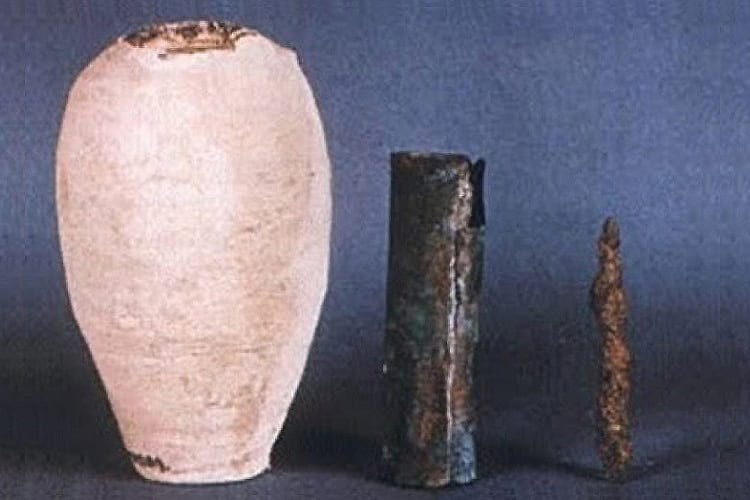
Components of Baghdad battery. (Unknown)
The interest in ancient civilisations heightened after the end of World War I, especially in Iraq. Evidence of human settlements goes back to several decades ago in Mesopotamia, also known as the ‘Cradle of civilisation‘. Archaeologists from Europe and the United States were executing excavations all over Iraq, in an effort to understand the beginning of civilisation. It was during this period that a German archaeologist rediscovered a puzzling artefact in a museum’s collectibles in 1936. Consisting of three parts, this was named the Parthian Battery or the Baghdad Battery.
What is Baghdad Battery?
The Baghdad battery is an unassuming looking earthen jar of 10 to 14 centimetres in height, with a copper cylinder inside. The copper cylinder further has a vertical iron rod. The battery is believed to have been used as an electric battery. It has been categorised as an oopart, an out of place artefact, due to the advanced level of technological knowledge it represents. An oopart is an ancient relic showing some skilled work from a period when it does not seem possible for people to have had that kind of knowledge.
Several of these batteries were rediscovered by Dr. Wilhelm König, stored in the Iraq museum. Upon inspecting it closely, he discovered that the iron and the copper were insulated from each other with an asphalt stopper. This led him to theorise that it was probably used as a battery for electroplating. If the vessel was filled with an electrolytic solution, a small current could be generated due to the voltage difference between the two metals. Putting out the idea that ancient civilisations were probably able to generate some form of electricity, centuries before human knowledge and technology could achieve it.
How was Baghdad Battery discovered?
Back in 1922, an archaeologist, Gertrude Margaret Lowthian Bell of Great Britain, started to store all dug up collectables in a government building in Baghdad. The government decided to move these priceless artefacts to another building and established it as the Baghdad Archaeological Museum, with Bell as the museum director. It was officially opened in June 1926, a little before Bell’s death on July 12, 1926.
More than a decade later, a German archaeologist, Dr. Wilhelm König was appointed as the Assistant Director of the Baghdad Antiquities’ Administration. He went on to take over as Director of the Baghdad Museum Laboratory in 1934 and subsequently discovered this battery. Later, he went on to publish a paper on it. By 1966 the museum had been further moved to a bigger two-story building and renamed National Museum of Iraq. What followed were the various experiments to determine the authentic use of the battery and its strange disappearance.
The experiments to prove the functioning of the battery
An engineer, Willard F.M. Gray came across Dr. König’s paper in 1940 and was fascinated by the concept of the Baghdad Battery. He was working at the General Electric High Voltage Laboratory in Pittsfield, Massachusetts at that time and decided to make a model of the battery. Studying the drawings and other details given by renowned rocket scientist Willy Key of German origin, Gray was able to recreate the battery. When he filled it with copper sulfate solution, he discovered that it could generate a small amount of electricity of 0.5 volts.
A fascinating fact was aired on the episode ‘Ancient Wisdom‘ of the British television series, Arthur C. Clarke’s Mysterious World on September 16, 1980. In this episode, German Archaeologist, Dr. Arne Eggebrecht said that after filling the battery container with grape juice, he was able to record a current of 0.87 volts. This led to the speculation that batteries were invented long before their known invention in 1799 by Alessandro Volta, further leading to the assumption that the batteries were probably also used during Egyptian civilisations where electroplated metals have been found.
Assumptions have been rife about the various uses of the battery. Ancient Greeks were known to treat pain with an electric eel, leading to the possibility of the batteries being used to treat pain. Some have suggested that the containers were merely holders for paper scrolls, with the paper wrapped around the iron rod and preserved by the copper jar. Theories of the battery being used inside idols of worship to inject a small current into those who dared to touch the Gods also did rounds.
The disappearance of the battery
A little prior to the invasion of Iraq on March 20 in 2003, the museum closed its doors to the public. Nearly 8,366 small items were hidden away at a storage location, sworn not to be revealed to anyone, by a few members of the staff. The larger ones that could not be moved and a few other items were covered with foam and rubber for protection. On April 10 in 2003, the museum was plundered and more than 10,000 items were stolen. One of those was the Baghdad Battery. An assessment of losses incurred and an investigation report was submitted by US Marine Colonel Matthew Bogdanos, who made an extensive list of the number of stolen artefacts. Bogdanos was convinced that the stealing had taken place in 3 parts in different instances.
Due to a local amnesty programme, and through seizures, around 3,037 items were recovered by January 2004. A year later, by January 2005, the museum had received another 2,307 items that had been stolen. On January 30 in 2012, 45 missing relics were returned to Iraq by Germany. However, according to the general director of the museum, Amira Eidan, nearly 10,000 antique national treasures were still missing at that time. The National Museum of Iraq officially reopened to the public in February 2015. One of the rare artefact that is still missing is the Baghdad Battery.
The purpose and the current location of the Baghdad Battery, both remain a mystery till date. The Baghdad Battery is just one of the many unexplained ancient phenomena that have been encountered by modern man.
Enjoyed this article? Also, check out “Yakhchal: The Indigenous Fridge of Middle-East“.
Recommended Visit:
National Museum of Iraq | Baghdad, Iraq
Fact Analysis:
STSTW Media strives to deliver accurate information through careful research. However, things can go wrong. If you find the above article inaccurate or biased, please let us know at [email protected].
RELATED
The post The Curious Disappearance of the Baghdad Battery: A Parthian Period Relic, An Oopart appeared first on .
]]>The post Peacock Clock: An 18th Century Automaton Marvel appeared first on .
]]>
Peacock clock at Hermitage Museum. (Antonio Zugaldia / Flickr)
The Hermitage Museum of Saint Petersburg, Russia is not only the second-largest art museum in the world but it also houses the only last 18th Century automaton in a fully functioning condition. The museum was founded in 1764 when Catherine the Great, the Empress of Russia, purchased enough paintings from a Berlin merchant to open a gallery.
One of the pieces, the Peacock Clock designed by James Cox, is a magnificent work of 18th century automaton art in this museum. The clock features 3 life-sized mechanical birds that move and act like real birds. There’s a peacock, a cockerel, and an owl inside a cage that are most prominent among other forest animals and elements like a squirrel, tree branches, and mushrooms.

The peacock clock from the front. (Michael Shilyaev / Wikimedia Commons)
How does the peacock clock work?
The designer of the Peacock Clock, James Cox, was a jeweller and goldsmith in the second half of the 18th century who created so many automatons of birds and animals that he eventually opened up his own museum called Spring Gardens (in London). To fund pieces for the museum, Cox organized lotteries in Dublin and London. The peacock that he created for his museum was slightly different; it was perched on an oak stump that had 2 snakes entwined on it.
Around the same time, Catherine the Great’s Hermitage (Museum) was collecting exhibits for the museum. When James Cox’s creations were brought to her attention, she was smitten. She commissioned a gigantic automaton clock for the Hermitage Museum. In order to make the piece in the quickest time frame using the least amount of finances possible, Cox modified the existing peacock structure from his earlier lottery. The clock is used to represent the end of night and start of a day and hence puts up a very dramatic show. The owl in the cage turns its head to some eerie chime music, after which the peacock moves its tail very gracefully to display its gilded fan of feathers. Finally, the cockerel crows to signify the end of the show. The dial of the clock is displayed covertly on the head of a mushroom. Cox used the assistance of a German craft smith who manufactured the clock in London. It was them shipped to Russia in pieces and set to work by a Russian mechanic called Ivan Kuliblin.

Peacock clock up close. (Michael Shilyaev / Wikimedia Commons)
The Hermitage Museum
Apart from the Peacock Clock, the Hermitage museum also contains other noteworthy pieces of art and culture. Even though the museum was founded in 1764, it was only opened to the public after more than 80 years in 1852. The museum now showcases only a fraction of more than 3 million pieces that it has, and is world-renowned for its largest collection of paintings. The collection is spread over 6 buildings, out of which only 5 are open to the public: the Winter Palace, the Small Hermitage, the Old Hermitage, the New Hermitage, and the Hermitage Theatre.
The work here was purchased by Catherine the Great from a Berlin merchant who organized paintings from notable painters like Rembrandt, Peter Rubens, Jacob Jordaens, Anthony Van Dyk, and Raphael among others. A majority of the paintings from the original collection are still intact and are at display at the Hermitage. Interestingly, in 1991 it was revealed that the Hermitage held paintings that were looted by the Red Army in Germany. It was only 3 years later that they revealed a collection of Impressionist and Post-Impressionist paintings including those by Van Gogh, Degas, and Renoir.
Enjoyed this article? Also, check out “Leonardo’s Robot: Leonardo da Vinci’s Mechanical Knight and Other Robots“.
Recommended Visit:
Hermitage Museum | Saint Petersburg, Russia
Fact Analysis:
STSTW Media strives to deliver accurate information through careful research. However, things can go wrong. If you find the above article inaccurate or biased, please let us know at [email protected].
RELATED
The post Peacock Clock: An 18th Century Automaton Marvel appeared first on .
]]>The post Deep Blue – The IBM Chess Computer That Beat Chess Grand Master Garry Kasparov in 1997 appeared first on .
]]>
Garry Kasparov playing chess with multiple opponents, 1985. (GFHund / Wikimedia Commons)
Deep Blue was a chess-playing computer that IBM developed which became famous for playing a game against the reigning chess champion, Garry Kasparov, in 1996, and winning a match against him in 1997.
Origins of Deep Blue

An identical version of the Deep Blue at Computer History Museum, California. (Jim Gardner / Flickr)
In 1985, three computer science students at Carnegie Mellon University, Feng-hsiung Hsu, Thomas Anantharaman and Murray Campbell, built the chess-playing computer ChipTest. From this computer came a more improved version, Deep Thought. The project caught the attention of IBM and, after Feng-hsiung Hsu and Murray Campbell graduated, the company hired them to develop the Deep Thought project further. Thomas Anantharaman joined the company sometime later, but, after a short stint, left IBM to go work on Wall Street. IBM then roped in another programmer, Arthur Joseph Hoane, and their long-time employee, Jerry Brody, to join the team. Chess players Nick DeFirmian, Miguel Illescas Cordoba, and John Fedorowicz worked on the computer’s chess game. Randy Moulic and Chung Jen Tan were the team managers.
From Deep Thought, they developed Deep Blue, using the C programming language and the AIX operating system. IBM had a contest to come up with a suitable name for their chess computer and the name Deep Blue was the winner.
Deep Blue vs Garry Kasparov
On 10 February 1996, the reigning chess world champion, Garry Kasparov, won a chess match against Deep Blue. It was big news. Everyone thought it remarkable that a computer could play chess with anyone, never mind with a reigning world champion. The computer won one game in a six-game match. Of the remaining five games, Garry Kasparov won two and three ended in draws. Kasparov won the match as a result.
Nobody was surprised that the reigning world champion won. Not in the least the Grand Master himself. He had already announced to the world that there wasn’t a machine around that could beat him.
After the defeat, IBM took their computer back for a serious upgrade, contracted a chess player, Grandmaster Joel Benjamin, to help them refine Deep Blue’s opening book, and then contacted Garry Kasparov for a rematch the following year.
This time around, in May 1997, Deep Blue won the six-game encounter with a 3.5-2.5 win. Whether it won the match fair and square is another matter and a subject of controversy. Garry Kasparov didn’t think it had and accused Deep Blue and IBM of cheating.
According to Kasparov, the computer showed such unexpectedly creative and sophisticated moves in the second game that it was probable that, in violation of the rules, human chess players had dipped their oars into the chess game. IBM denied it had cheated and maintained that its computer program developers had only modified the program, which the game rules allowed them to do. The company refused to let Kasparov see their computer logs, however, and also turned down his demand for a rematch. Instead, they retired and dismantled their digital champion.
Deep Blue versus human intelligence
IBM continued to claim though that it was a historic man versus machine match that the machine ultimately won. Everyone doesn’t agree with this view. Several chess masters, who have studied the match, feel that Garry Kasparov wasn’t at his very best during the match and made a few regrettable opening mistakes. Also, he was placed at a disadvantage with the machine. Deep Blue’s programmers had studied his past games and strategies and had altered their program algorithms to adapt to his style. They also tweaked and modified the program in between games. Kasparov, on the other hand, had no inkling of the computer’s game and the modification in between the games further put him at sea.
Deep Blue was capable of thinking six to eight moves ahead, sometimes even twenty or more moves ahead, while, according to Kasparov, he was accustomed to thinking three or five moves ahead. Also, unlike humans, Deep Blue stood in no danger of tiring from an entire day of chess playing and making mistakes due to fatigue, frustration, and anxiety.
Even so, if you consider that the computer was programmed to gauge 200 million positions in one second, Kasparov comes out looking very good in comparison.
Interestingly, what Kasparov claimed to be a sophisticated move on part of Deep Blue was nothing of the sort, according to the computer’s programmers. Fifteen years after the famous chess match, they told reporters that what Kasparov had taken to be intelligent human intervention was actually nothing more than a bug in the coding.
Deep Blue was followed by Fritz, a German chess program. Garry Kasparov played a match against Fritz in 2003 that ended in a draw.
Today, a chess-playing computer is no longer unique. It has become too ubiquitous. However, difficult chess programs remain in wide demand as chess masters used them to improve and refine their games.
Deep Blue and artificial intelligence
IBM’s real purpose in developing Deep Blue wasn’t to humiliate Chess Grand Masters but to tout the cause of artificial intelligence. We hear of artificial intelligence all the time nowadays. Back then it was a novelty, and, with its chess computer, IBM wanted to give the public a glimpse of the immense possibilities of artificial intelligence. If it could play a chess game so well, just imagine how useful it would be in running the world and ridding us of human-created errors.
What these purveyors of artificial intelligence rarely mention – and what is actually glaringly obvious – is that if artificial intelligence ever comes to reign over us, it will be as in the actual reality of democracy, the reign of a few over the mass of the public. The few that will code the program for artificial intelligence will get to decide how the rest of us are to live and exist. It is not at all a comforting scenario. Imagine having your entire life at the mercy of an unknown computer programmer. If they are magnanimous, broadminded people with a talent for writing errorless code, you will have nothing to complain about. If they are not, you might end up having nowhere to complain to.
Enjoyed this article? Also, check out “The Turk: The 18th Century Automaton Chess Player was a Fore-Runner of Computer Age“.
Recommended Visit:
Computer History Museum | California, United States
Fact Analysis:
STSTW Media strives to deliver accurate information through careful research. However, things can go wrong. If you find the above article inaccurate or biased, please let us know at [email protected].
RELATED
The post Deep Blue – The IBM Chess Computer That Beat Chess Grand Master Garry Kasparov in 1997 appeared first on .
]]>The post The Turk: 18th Century Automaton Chess Player was a Forerunner of Computer Age appeared first on .
]]>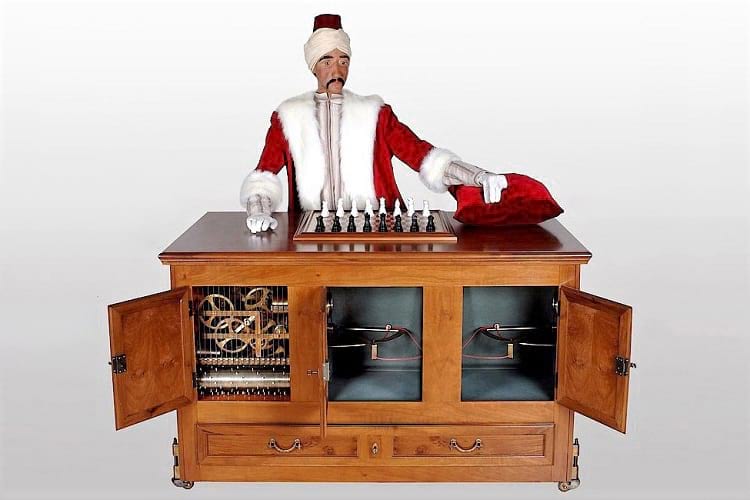
The Mechanical Turk and its inner working. (© Jan Braun / Heinz Nixdorf MuseumsForum / Used With Permission)
Man’s fascination for machines and gizmos predates industrial revolution when machines were replacing manual labour, draught power, and even entertainment in a big way. Then a path-breaking feat happened in the 18th century. A machine arrived on the scene not to replace horsepower, but cerebral power. It was a replacement for man’s ability to think critically. A machine could play chess against a man, and more often than not, beating him in the game.
The machine, the Turk was a mannequin of a sorcerer like, a wide-eyed, turbaned and moustachioed man sitting behind three and a half feet long, two feet wide and two and a half feet high wooden cabinet studded with Chess Board. Automaton Chess Player or the Robotic Chess Player were other names for The Turk. The machine was conceived, created and designed by Viennese Engineer Wolfgang von Kempelen in 1770.
Projected as chess playing contraption, the machine remained in vogue, though intermittently, for 84 years, giving tough time to whosoever sat on the rival’s seat. It defeated best of chess masters and became a rage. How the machine really worked, would take time to become public. In those days of the industrial revolution, machines of all shades and description evoked immense awe and surprise for their physical output. And here was one doing mental work of tall order. People hooked to magic shows for entertainment in those days couldn’t have asked for more.

The reconstructed version of The Turk at the Heinz Nixdorf Museum, Germany. (Marcin Wichary / Flickr)
Theories about the working of the Automaton Chess Player
The inaugural show of the Robotic Chess Player was held in Habsburg court in Vienna. Maria Theresa, the Queen of Hungary and Bohemia, was deeply impressed. After the inaugural show, the Turk went into a hiatus till after Maria’s death, her son Joseph II would revive it. In a 1783 Paris show, Benjamin Franklin played with the machine and lost.
In the following years, it toured England and Germany and came on the radar of sceptics. People started doubting the Turk. British author Philip Thicknesse said an automation couldn’t be passed as a chess player. He rejected the possibility of chessboard being manipulated from distance, magnetically or otherwise, as many believed. However, he proposed that the cabinet concealed a child of 10, 12 or 14 years, who was exceptionally talented in the game of chess.

The Turk. (Carafe / Wikimedia Commons)
Just as a magician shows his empty hands to crowds before performing tricks, Von Kemplen showed innards of the cabinet, revealing largely empty space, and an ensemble of cogwheels as if those were the brain of the Robot machine. Hand movement of Turk was precise, man-like, in placing chess pieces on board. The other player was chosen from the crowd.
Compared to the-then prevalent shows of animal and human dummies, the Turk provided a far superior option for mass entertainment. It was a dummy not only moving head and hands but also expressing anxiety and indignation like Chess wizard. When Napoleon Bonaparte, the iconic opponent of Turk, tried to cheat, the angered Robot uprooted all chess pieces, amusing Napoleon to no end.
So how did the Mechanical Turk work?
The maverick machine had to put up with some-one-is-hiding-inside-the-cabinet theory for decades. The cabinet was big enough to house an individual, child or an adult, who could execute chess moves directly or by some kind of remote control. The concealed person hid in the bottom drawer as the cabinet was opened for the perusal of the audience in candlelight. The hidden person being a fugitive amputee and good-at-chess Polish soldier, Worousky, who Von Kempelen met in Russia, was also mooted.

Illustration from a book trying to explain the workings of the Mechanical Turk. (Joseph Racknitz / Wikimedia Commons)
Hearsays and rumours added to the mystique of the Chess machine but the truth was plain and simple. There indeed was a skilled operator inside the cabinet, trained and groomed for the game.
The mystique of the chess playing Turk grew by the day. Robert Willis, English Academic and Mechanical Engineer, 1821, wondered what more could these humanoid machines accomplish in times to come. Charles Babbage, the English Polymath, was so impressed he got down to work for a machine which could automatically calculate and tabulate mathematical functions, a harbinger of present-day Artificial Intelligence. Tom Standage wrote “…… (A machine like Turk) raised the possibility that machines might eventually be capable of replacing mental activity too.”
What made The Turk so impressive?
The explanation lies in the surprise element which it was able to generate. The game began with the mannequin moving head sideways to survey the chessboard. The grim expression on the wooden face, moving eyes, the gentle tapping on board in a manner of brainstorming, moustaches and headgear of an oriental magician; all these combined to overawe, if not unnerve, the rival player. And then there were instances when machine threw tantrums over perceived cheating by the opponent.
With the death of Kampelene in 1804, Turk came in the custody of Bavarian showman Johann Nepomuk Maelzel who organized shows in the USA in the 1820s and 30s. In 1830s Maelzel, as well as the hidden operator of Turk, died of yellow fever in Cuba.
Noted American writer Edgar Allan Poe, published an essay in 1836 to prove that Turk was assisted by a hidden human. By 1850, hysteria generated by Turk was on the wane. Left as antique in a Chinese museum in Philadelphia, it was destroyed in a fire breakout in 1854. The final nail in the coffin of The Turk came from Dr. Silas Mitchell in 1860. He elaborately revealed secrets of the Automaton Chess Machine in his magazine named ‘Chess Monthly’.
Yet, it would be an understatement to call Turk just a hoax or a clever deceit. The frenzy that it generated in heydays impacted laymen and elite alike. Father of the present day Computer, Charles Baggage, was defeated twice by the automaton. The machine and magic combo – Turk verily foreshadowed Artificial Intelligence of today. And that’s no ordinary gift of the Turk to the posterity.
Enjoyed this article? Also, check out “Euphonia: The Sad Story of Joseph Faber and His Creepy Machine That Made Ghostly Sounds“.
Recommended Visit:
Heinz Nixdorf Museum | Paderborn, Germany
Fact Analysis:
STSTW Media strives to deliver accurate information through careful research. However, things can go wrong. If you find the above article inaccurate or biased, please let us know at [email protected].
RELATED
The post The Turk: 18th Century Automaton Chess Player was a Forerunner of Computer Age appeared first on .
]]>The post Yakhchal: The Indigenous Fridge of Middle-East appeared first on .
]]>
Yakhchal in a desert, Iran. (Jeanne Menjoulet / Flickr)
Around 400 BC, Persians had invented a cooler that enabled them to store ice year-round. This cooler goes by the name of yakhchāl, which is a Persian word comprising of two words, ‘yakh’ meaning ice, and ‘chāl’ meaning pit.
The structure of yakhchāl is divided into two parts, one above the surface and one below. Above the surface, the yakhchāls could rise up to a height of 18 meters. From a distance, Yakhchal looks like a mud-brick, domed-shaped structure. The storage space is situated beneath the surface.
As far as the volume is concerned, the yakhchāl provided an ample storage space of about 5000 cubic meters. People used this for storing ice, water, and even perishable items including vegetables and fruits. Once the water was added to the yakhchāl, it froze due to the low temperature inside.
How does yakhchāl work?
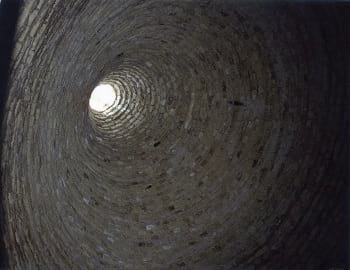
Inside yakhchal. (Jeanne Menjoulet / Flickr)
The main reason why yakhchāl worked so effectively lies in its design, which is based on aerodynamics. The yakhchāl is designed to be conical in structure with a hole at the top. This hole allows the cold air to enter the yakhchāl and pave its path all the way down to the bottom. The conical architecture of the yakhchāl allows the hot air to rise up to the top and exit, maintaining a cooler environment inside.
The materials used for the construction of yakhchāl also plays a major role. The walls of the ‘desert cooler’ were made up of insulating materials. A traditional mortar called sarooj, prominently used in Iranian construction, was used in these coolers. Sarooj is made by mixing clay, sand, lime, egg whites, ash and goat hair in a fixed proportion. This special mortar provided ultimate insulation to the cooler.
In some cases, a wind catching towers were used to direct the wind inside the desert fridge. Moreover, the storage space was surrounded by walls as thick as two meters and was cleverly located below the surface.

Wind catching tower. (Diego Delso / Wikimedia Commons)
During winter, people gathered snow from the nearby mountains and bought them to the yakhchāl. In case this was not a feasible option, water was directed to it through nearby groundwater pools or springs via ‘qanāts‘.
Qanāt refers to a system of transporting water from underground water sources through a gradually sloped channel.
The inventors of this marvel understood the importance of water. As a consequence, trenches were made at the bottom to capture the ice that might have melted into the water during the day. At night, this captured water froze again due to the drop in temperature. This created a cycle that maximised efficiency while minimising the environmental impact.
But, perhaps, the most distinctive feature of the yakhchāl doesn’t lie in its capabilities, but, in its accessibility. It is said that the desert fridge didn’t only cater to the needs and luxuries of royals but was accessible to everyone.
While most of the yakhchāl have not been able to withstand the ravages of time, some of them are still very well preserved and can be found across middle-eastern countries.
Enjoyed this article? Also, check out “Ice House: Here’s How Our Ancestors Stored Ice“.
Fact Analysis:
STSTW Media strives to deliver accurate information through careful research. However, things can go wrong. If you find the above article inaccurate or biased, please let us know at [email protected].
RELATED
The post Yakhchal: The Indigenous Fridge of Middle-East appeared first on .
]]>



